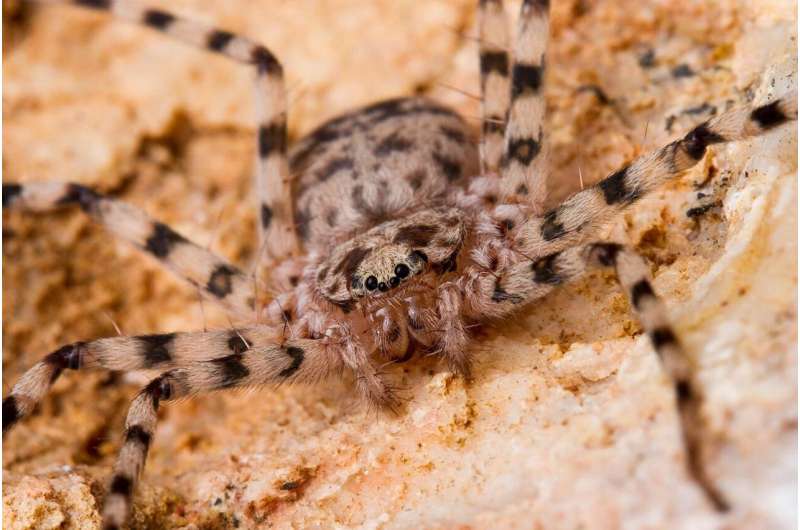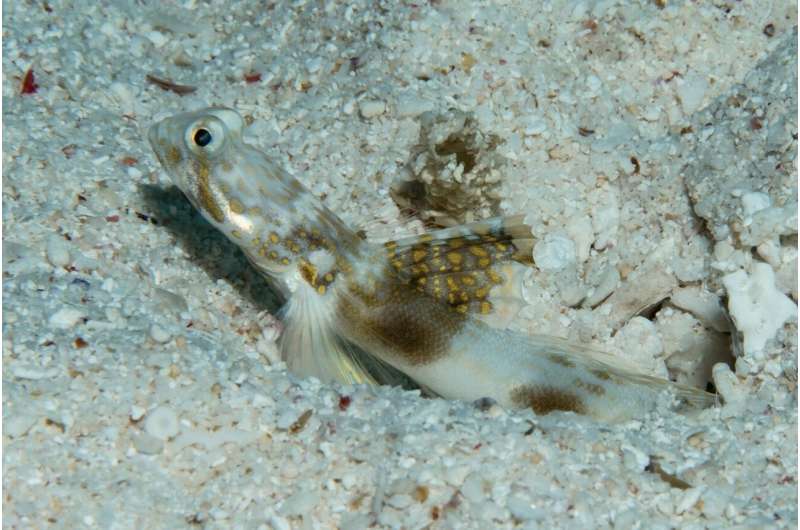This article has been reviewed according to Science X's editorial process and policies. Editors have highlighted the following attributes while ensuring the content's credibility:
fact-checked
trusted source
proofread
Scientists describe 153 new species in 2023

Researchers at the California Academy of Sciences described 153 new animal, plant, and fungi species in 2023, enriching our understanding of Earth's biodiversity and strengthening our ability to regenerate the natural world. The new species include 66 spiders, 20 sea slugs, 18 plants, 13 sea stars, 12 geckos, 10 beetles, five fishes, four worms, two wasps, one sea snail, one scorpion, and one legless skink. More than a dozen Academy scientists—along with several international collaborators—described the new-to-science species.
This year's discoveries coincide with the 50th anniversary of the Endangered Species Act (ESA), and include several threatened plant and animal species that meet the criteria for formal ESA protections. These protections include prohibiting any harmful treatment of protected species; requiring further protection for land where endangered species occur; and implementing recovery plans for threatened populations.
"This year we are celebrating the 50th anniversary of the The Endangered Species Act, which has been directly responsible for saving hundreds of species," Academy Executive Director Scott Sampson, Ph.D., says.
"Yet a million more species remain imperiled due to human-driven activities like habitat destruction, climate change, and pollution. We must document the Earth's living diversity so that we can work to protect it, and the California Academy of Sciences is honored to take part in this critical global effort. Additionally, we must aim beyond protection toward regeneration, boosting the health and resilience of ecosystems for future generations of humans and nonhumans alike. Here, too, the Academy is deeply engaged through our bold mission to regenerate the natural world."
Proving that our vast and dynamic planet still harbors unexplored places with never-before-recorded plants and animals, the scientists made their finds across six continents and four oceans. Read the Academy's blog, Phenomena, for more details on how researchers are still finding and describing dozens of new species every year.
Here are some of the highlights from the 153 species described by the Academy this past year
An endangered scorpion from the San Joaquin Desert
After describing two new-to-science scorpions in 2022, Academy interns Harper Forbes and Prakrit Jain, along with Academy graduate student Jacob Gorneau and Curator of Arachnology Lauren Esposito, Ph.D., added a new member to California's growing list of scorpions: Paruroctonus tulare. Though the species was first spotted in the Tulare Basin by an iNaturalist user in 2020, it took the now-undergrads more than two years of sampling across the San Joaquin Desert to formally describe the species.
"We checked every plot of land in the area that hadn't been developed for agricultural use," Jain recounts. "Unlike P. soda and P. conclusus, which only occur in very narrow patches of land in Central California, we were able to identify P. tulare from 12 different sites."
Human-driven pressures like climate change and agricultural development motivated the study authors to immediately seek out ESA protections for the new scorpion. "This is the first time the conservation status of a new-to-science scorpion has been evaluated at the same time as its discovery," says Esposito.
"Many endangered species—scorpions included—have likely gone extinct before they could be formally described. It's crucial that we garner protections as early as possible: First at the international level by adding them to the International Union for Conservation of Nature (IUCN) Red List, and second at national and state levels by giving them ESA protections."
A legless lizard lurking in the leaf litter
Academy research associate Aaron Bauer, Ph.D., describes Acontias mukwando, a legless skink from the sparsely wooded slopes of Serra da Neve—the second-tallest mountain in Angola.
Like many members of the skink family, this limbless lizard behaves somewhat like a snake, stealthily slinking through the leaf litter on the forest floor in search of insects and small prey animals. But unlike other related skinks, which are typically uniform in color, A. mukwando has a distinct pinkish collar around its neck—which instantly gave it away as a new species.
Serra da Neve is an isolated mountain on the northern edge of the arid Namib Desert. Bordered by a sea of sand, this standalone peak is characterized by a cooler, more humid environment that harbors a wealth of microendemic species, or species found in an extremely small geographic range. Though it is home to plants and animals found nowhere else on Earth, Serra de Neve is not formally protected in any way.
"Each new species we describe from this mountain—and others like it—is evidence that places like these deserve some sort of conservation consideration," Bauer says. "We're still finding new species on these isolated 'islands," which tells us it's not too late for protection."

Fast and flat: 19 new Australian spiders
Academy researcher Sarah Crews, Ph.D., added 19 new-to-science flattie spiders from western Australia to the Karaops genus this year. Known for their incredible turning speed, these small, flat spiders have the fastest turning strike of any terrestrial animal on the planet. Only one to two millimeters in height—about as tall as a strand of spaghetti is wide—they can spin nearly 3,000 degrees per second.
When Crews started researching this group of flattie spiders in Australia in 2010, only one species of Karaops had been formally identified. But over the last decade, Crews has added 53 more species to the genus. She says, "they're not necessarily uncommon, just incredibly difficult to catch."
A cliff-dwelling succulent with local roots
While a species may be new to western scientists, many have existed for millennia and have long been recognized by local Indigenous communities. This year, Academy researcher Isaac Lichter Marck, Ph.D., and collaborating scientists from the Instituto Politécnico Nacional in Durango, Mexico, described a rare, cliff-dwelling succulent Pachyphytum odam from the Sierra Madre Occidental mountain range.
But for centuries, O'dam people in the nearby community of La Muralla have known this plant as da'npakal, a native word for bald, naked, or slippery (alluding to the succulent's bald leaves and stems). Describing researchers use the epithet odam in honor of the O'dam people and their land where the plant grows
Senior author and collaborating researcher Arturo Castro-Castro, Ph.D., explains the importance of connecting a species name to local cultural identity: "The O'dam know their territory better than anyone and maintain a close relationship with their local biodiversity. They preserve an incomparable biocultural heritage and extensive plant-related traditional knowledge."

A shrimp goby hiding in plain sight
Waiting to spot a manta ray from the ocean floor, Academy research associate Mark Erdmann, Ph.D., stumbled upon the newly described Lady Elliot goby (Tomiyamichthys elliotensis), a new-to-science shrimp goby from Lady Elliot Island on the Great Barrier Reef. Shrimp gobies are shallow-water reef fish that inhabit sandy seabeds near coral reefs, and have a symbiotic relationship with alpheid snapping shrimp: The shrimp excavate burrows in the sand, and the gobies act as their security guards, keeping an eye out for nearby predators.
Erdmann, who studies everything from gobies to whale sharks, explains that small fishes like shrimp gobies are less of a conservation concern than larger, more iconic species. But for the first time, ichthyologists are convening to formally assess their conservation status in the spring of 2024.
"These fishes live fast, breed fast, and die fast," Erdmann says. "But the same stressors that affect more charismatic species—climate change, habitat degradation, and pollution—are likely affecting these smaller fishes, too."
Misidentified flowering plant revealed in Costa Rica
Academy botanists revealed that a common flowering plant from Costa Rica had been mistakenly categorized as a separate, similar species for more than 150 years. Described this year by Academy researchers Tom Daniel, Ph.D., and Ricardo Kriebel, Ph.D., Stenostephanus purpureus was misidentified as the morphologically similar S. silvaticus, a flowering plant from Mexico, when it was first collected in 1855. Though he has identified and collected the newly described species several times, Kriebel caught the error while trawling iNaturalist observations within the genus.
"I never questioned the identification of the Costa Rican specimens," Kriebel says, "not until I did a side-by-side comparison with images of living plants from Mexico. The differences between the two are subtle when you're working with dead, dry specimens from collections."
S. purpureus and S. silvaticus differ in both flower color and pollen morphology. Another notable distinction is the absence of a "landing pad," or a flat petal used by butterflies and other insects for pollination, in the Costa Rican plant. This suggests S. purpureus may have evolved to rely on hummingbird pollination rather than insect pollination.
More information: Read the Academy's blog for more details on how researchers are still finding and describing dozens of new species every year.
Provided by California Academy of Sciences


















